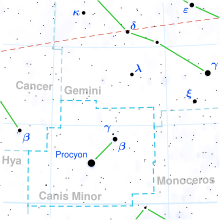| Observation data Epoch J2000.0 Equinox J2000.0 (ICRS) | |
|---|---|
| Constellation | Canis Minor |
| Right ascension | 07h 28m 09.79333s[1] |
| Declination | +08° 55′ 31.9068″[1] |
| Apparent magnitude (V) | +4.33[2] (4.46 + 6.66)[2] |
| Characteristics | |
| Spectral type | K3 III Fe-0.5[3] (K4 III + K1: III)[2] |
| U−B color index | +1.53[4] |
| B−V color index | +1.43[4] |
| Astrometry | |
| Radial velocity (Rv) | 46.8±0.3[5] km/s |
| Proper motion (μ) | RA: −61.09[1] mas/yr Dec.: −10.70[1] mas/yr |
| Parallax (π) | 10.25 ± 0.47 mas[1] |
| Distance | 320 ± 10 ly (98 ± 4 pc) |
| Absolute magnitude (MV) | −0.5±0.1[2] |
| Absolute magnitude (MV) | 1.7±0.2[2] |
| Orbit[2] | |
| Period (P) | 389.310 ± 0.012d |
| Semi-major axis (a) | 17 mas |
| Eccentricity (e) | 0.25856 ± 0.00039 |
| Inclination (i) | 66° |
| Periastron epoch (T) | 2449849.172 ± 0.089 HJD |
| Argument of periastron (ω) (secondary) | 142.079 ± 0.090° |
| Semi-amplitude (K1) (primary) | 21.243 ± 0.010 km/s |
| Semi-amplitude (K2) (secondary) | 21.526 ± 0.017 km/s |
| Details[2] | |
| γ CMi A | |
| Mass | 1.88 M☉ |
| Radius | 36.8±2.6 R☉ |
| Luminosity | 321±33 L☉ |
| Temperature | 4,036±100 K |
| Rotational velocity (v sin i) | 5±2 km/s |
| Age | 1.3 Gyr |
| γ CMi B | |
| Mass | 1.85 M☉ |
| Radius | 7.8±1.0 R☉ |
| Luminosity | 25.4±5.2 L☉ |
| Temperature | 4,658±200 K |
| Rotational velocity (v sin i) | 2.0±2.0 km/s |
| Other designations | |
| Database references | |
| SIMBAD | data |
Gamma Canis Minoris (γ Canis Minoris) is a binary star system in the equatorial constellation Canis Minor. Its orange colour is obvious when seen through binoculars.[7] The system is visible to the naked eye with a combined apparent visual magnitude of +4.33.[2] Based upon an annual parallax shift of 10.25 mas as seen from Earth,[1] this system is located about 320 light years from the Sun.
This spectroscopic binary star system has an orbital period of 389.31 days, a semimajor axis of 1.48 AU, and an eccentricity of 0.2586.[2] Their variable radial velocity was discovered by H. M. Reese in 1902 at Lick Observatory.[8] Both components are evolved, K-type giant stars, most likely on their first ascent along the red giant branch. The primary, component A, has a stellar classification of K4 III while the secondary, component B, may be K1: III.[2]
- ^ a b c d e f Cite error: The named reference
vanLeeuwen2007was invoked but never defined (see the help page). - ^ a b c d e f g h i j Cite error: The named reference
Fekel2013was invoked but never defined (see the help page). - ^ Cite error: The named reference
perkins1989was invoked but never defined (see the help page). - ^ a b Cite error: The named reference
Johnson1966was invoked but never defined (see the help page). - ^ Cite error: The named reference
deBruijne2012was invoked but never defined (see the help page). - ^ Cite error: The named reference
SIMBADwas invoked but never defined (see the help page). - ^ Cite error: The named reference
kambic2009was invoked but never defined (see the help page). - ^ Cite error: The named reference
Campbell1902was invoked but never defined (see the help page).
